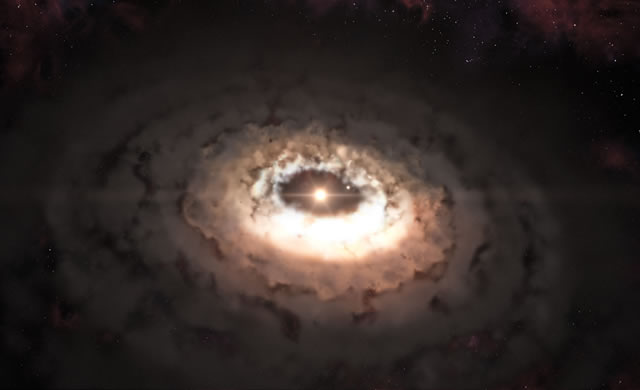
Alcuni astronomi, usando ALMA (Atacama Large Millimeter/submillimeter Array), hanno ripreso, vicino a una giovane stella, la regione in cui le particelle di polvere possono aggregarsi e quindi crescere. È la prima volta che viene osservata chiaramente e modellata una simile “trappola per la polvere”. Si risolve un mistero di lunga data su come le particelle di polvere nei dischi stellari crescano fino a raggiungere dimensioni così grandi da formare, alla fine, comete, pianeti e altri corpi rocciosi. I risultati del lavoro vengono pubblicati dalla rivista Science il 7 giugno 2013.
Gli astronomi ora sanno che i pianeti si trovano in abbondanza intorno ad altre stelle. Ma non comprendono ancora fino in fondo come essi si formino e anche molti altri aspetti della formazione di comete, pianeti e altri corpi rocciosi sono ancora oscuri. Ora le nuove osservazioni, che sfruttano la potenza di ALMA, stanno rispondendo a una delle più importanti tra queste domande: come fanno i minuscoli grani di polvere nel disco intorno a una stella giovane a diventare sempre più grandi – fino a diventare sassolini e oltre, fino a massi ben più grandi di un metro? Modelli numerici suggeriscono che i grani di polvere crescano quando entrano in collisione e rimangono attaccati tra loro. Ma quando questi grani più grandi si scontrano di nuovo ad alta velocità, spesso vengono distrutti e si ritorna al punto di partenza. Anche quando ciò non accade, i modelli mostrano che i grani più grandi si muovono velocemente verso l’interno a causa dell’attrito tra la polvere e il gas e cadono sulla stella madre, eliminando ogni possibilità di crescere ulteriormente. In qualche modo la polvere ha bisogno di un rifugio sicuro dove le particelle possono continuare a crescere finchè sono abbastanza grandi per sopravvivere da sole. Tali “trappole per la polvere” erano state proposte ma finora non c’era nessuna prova osservativa della loro esistenza.
Fonte/Leggi tutto → ESO.org
Astronomers using the new Atacama Large Millimeter/submillimeter Array (ALMA) have imaged a region around a young star where dust particles can grow by clumping together. This is the first time that such a dust trap has been clearly observed and modelled. It solves a long-standing mystery about how dust particles in discs grow to larger sizes so that they can eventually form comets, planets and other rocky bodies. The results are published in the journal Science on 7 June 2013.
Astronomers now know that planets around other stars are plentiful. But they do not fully understand how they form and there are many aspects of the formation of comets, planets and other rocky bodies that remain a mystery. However, new observations exploiting the power of ALMA are now answering one of the biggest questions: how do tiny grains of dust in the disc around a young star grow bigger and bigger — to eventually become rubble, and even boulders well beyond a metre in size? Computer models suggest that dust grains grow when they collide and stick together. However, when these bigger grains collide again at high speed they are often smashed to pieces and sent back to square one. Even when this does not happen, the models show that the larger grains would quickly move inwards because of friction between the dust and gas and fall onto their parent star, leaving no chance that they could grow even further. Somehow the dust needs a safe haven where the particles can continue growing until they are big enough to survive on their own. Such “dust traps” have been proposed, but there was no observational proof of their existence up to now.
Source/Continue reading → ESO.org





















